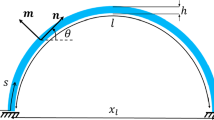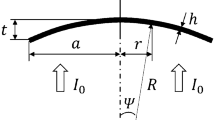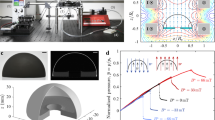Abstract
In bistable actuators and other engineered devices, a homogeneous stimulus (e.g., mechanical, chemical, thermal, or magnetic) is often applied to an entire shell to initiate a snap-through instability. In this work, we demonstrate that restricting the active area to the shell boundary allows for a large reduction in its size, thereby decreasing the energy input required to actuate the shell. To do so, we combine theory with 1D finite element simulations of spherical caps with a non-homogeneous distribution of stimulus-responsive material. We rely on the effective curvature stimulus, i.e., the natural curvature induced by the non-mechanical stimulus, which ensures that our results are entirely stimulus-agnostic. To validate our numerics and demonstrate this generality, we also perform two sets of experiments, wherein we use residual swelling of bilayer silicone elastomers—a process that mimics differential growth—as well as a magneto-elastomer to induce curvatures that cause snap-through. Our results elucidate the underlying mechanics, offering an intuitive route to optimal design for efficient snap-through.
Graphical abstract







Similar content being viewed by others
Data Availability Statement
This manuscript has associated data in a data repository. [Authors’ comment: The datasets may be accessed at https://doi.org/10.5281/zenodo.5822440.]
References
Y. Forterre, J.M. Skotheim, J. Dumais, L. Mahadevan, Nature 433(7024), 421 (2005). https://doi.org/10.1038/nature03185
R. Sachse, A. Westermeier, M. Mylo, J. Nadasdi, M. Bischoff, T. Speck, S. Poppinga, Proc. Natl. Acad. Sci. 117(27), 16035 (2020). https://doi.org/10.1073/pnas.2002707117
M. Smith, G. Yanega, A. Ruina, J. Theor. Biol. 282(1), 41 (2011). https://doi.org/10.1016/j.jtbi.2011.05.007
H. Shao, S. Wei, X. Jiang, D.P. Holmes, T.K. Ghosh, Adv. Func. Mater. 28(35), 1802999 (2018). https://doi.org/10.1002/adfm.201802999
B. Gorissen, D. Melancon, N. Vasios, M. Torbati, K. Bertoldi, Sci. Robot. 5(42), eabb1967 (2020). https://doi.org/10.1126/scirobotics.abb1967
D. Holmes, A. Crosby, Adv. Mater. 19(21), 3589 (2007). https://doi.org/10.1002/adma.200700584
J.Y. Song, S. Heo, J. Shim, Technol. Architect. Des. 2(1), 45 (2018). https://doi.org/10.1080/24751448.2018.1420964
M. Taffetani, X. Jiang, D.P. Holmes, D. Vella, Proc. R. Soc. A 474(2213), 20170910 (2018). https://doi.org/10.1098/rspa.2017.0910
G. Wan, Y. Cai, Y. Liu, C. Jin, D. Wang, S. Huang, N. Hu, J.X. Zhang, Z. Chen, Extreme Mech. Lett. 42, 101065 (2021). https://doi.org/10.1016/j.eml.2020.101065
A. Pandey, D.E. Moulton, D. Vella, D.P. Holmes, Europhys. Lett. 105(2), 24001 (2014). https://doi.org/10.1209/0295-5075/105/24001
M. Jakomin, F. Kosel, T. Kosel, Thin-Walled Struct. 48(3), 243 (2010). https://doi.org/10.1016/j.tws.2009.10.005
K.A. Seffen, S. Vidoli, Smart Mater. Struct. 25(6), 065010 (2016). https://doi.org/10.1088/0964-1726/25/6/065010
A. Goriely, The Mathematics and Mechanics of Biological Growth (Springer, Berlin, 2017)
J.H. Lee, H.S. Park, D.P. Holmes, Phys. Rev. Lett. 127(13), 138102 (2021). https://doi.org/10.1103/physrevlett.127.138102
M. Pezzulla, N. Stoop, M.P. Steranka, A.J. Bade, D.P. Holmes, Phys. Rev. Lett. 120, 048002 (2018). https://doi.org/10.1103/PhysRevLett.120.048002
A.M. Abdullah, P.V. Braun, K.J. Hsia, Soft Matter 12(29), 6184 (2016). https://doi.org/10.1039/c6sm00532b
Y. Kim, J. van den Berg, A.J. Crosby, Nat. Mater. 20, 1695–1701 (2021). https://doi.org/10.1038/s41563-020-00909-w
S. Timoshenko, J. Opt. Soc. Am. 11(3), 233 (1925). https://doi.org/10.1364/JOSA.11.000233
E. Efrati, E. Sharon, R. Kupferman, J. Mech. Phys. Solids 57(4), 762 (2009). https://doi.org/10.1016/j.jmps.2008.12.004
Y. Klein, E. Efrati, E. Sharon, Science 315(5815), 1116 (2007). https://doi.org/10.1126/science.1135994
E. Sharon, E. Efrati, Soft Matter 6(22), 5693 (2010). https://doi.org/10.1039/c0sm00479k
V. Alastrué, E. Peña, M.Á. Martínez, M. Doblaré, Ann. Biomed. Eng. 35(10), 1821 (2007). https://doi.org/10.1007/s10439-007-9352-4
D.P. Holmes, J.H. Lee, H.S. Park, M. Pezzulla, Phys. Rev. E 102(2), 023003 (2020). https://doi.org/10.1103/physreve.102.023003
A. O’Halloran, F. O’Malley, P. McHugh, J. Appl. Phys. 104(7), 071101 (2008). https://doi.org/10.1063/1.2981642
T. Lu, C. Ma, T. Wang, Extreme Mech. Lett. 38, 100752 (2020). https://doi.org/10.1016/j.eml.2020.100752
A. Poulin, S. Rosset, H.R. Shea, Appl. Phys. Lett. 107(24), 244104 (2015). https://doi.org/10.1063/1.4937735
F.M. Weiss, T. Töpper, B. Osmani, S. Peters, G. Kovacs, B. Müller, Adv. Electron. Mater. 2(5), 1500476 (2016). https://doi.org/10.1002/aelm.201500476
M. Pezzulla, S.A. Shillig, P. Nardinocchi, D.P. Holmes, Soft Matter 11(29), 5812 (2015). https://doi.org/10.1039/C5SM00863H
M. Pezzulla, G.P. Smith, P. Nardinocchi, D.P. Holmes, Soft Matter 12, 4435 (2016). https://doi.org/10.1039/C6SM00246C
L. Stein-Montalvo, P. Costa, M. Pezzulla, D.P. Holmes, Soft Matter 15(6), 1215 (2019). https://doi.org/10.1039/C8SM02035C
A. Lucantonio, P. Nardinocchi, M. Pezzulla, Proc. R. Soc. A 470(2171), 20140467 (2014). https://doi.org/10.1098/rspa.2014.0467
W.T. Koiter, J.G. Simmonds, Theoretical and Applied Mechanics (Springer, Berlin, 1973), pp. 150–176
Y.C. Fung, W.H. Wittrick, Q. J. Mech. Appl. Math. 8(2), 191 (1955). https://doi.org/10.1093/qjmam/8.2.191
F. Niordson, Shell Theory (Elsevier Science, Amsterdam, 1985)
E. Efrati, E. Sharon, R. Kupferman, Phys. Rev. E 80(1), 016602 (2009). https://doi.org/10.1103/physreve.80.016602
D.P. Holmes, Curr. Opin. Colloid Interface Sci. 40, 118 (2019). https://doi.org/10.1016/j.cocis.2019.02.008
J.H. Lee, H.S. Park, D.P. Holmes, Forthcoming (2022)
A. Lee, P.T. Brun, J. Marthelot, G. Balestra, F. Gallaire, P.M. Reis, Nat. Commun. 7(1), 1–7 (2016). https://doi.org/10.1038/ncomms11155
Acknowledgements
We are grateful to Matteo Pezzulla for help with the COMSOL model, and to Kyle Hallock and Xin Jiang for helping to develop the experimental protocols. LSM, JHL, HSP, and DPH gratefully acknowledge the financial support from NSF through CMMI-1824882. YY & DPH gratefully acknowledge the financial support from Sartorius. ML, LSM & DPH also acknowledge support from the Research in Science & Engineering (RISE) program at Boston University.
Author information
Authors and Affiliations
Contributions
LSM carried out simulations, performed residual swelling experiments and data analysis, and wrote the manuscript. JHL developed the theory. YY carried out magneto-elastomer experiments. ML contributed to residual swelling experiments. HSP contributed to the theory. DPH conceived of the idea, supervised the study, contributed to the theory, and provided critical feedback on the manuscript.
Corresponding author
Appendices
A Fabrication of non-homogeneous residual swelling shells
The shell fabrication procedure for the active edge configuration is shown in Fig. 6. The process is as follows: To begin, we coat a metal ball-bearing (\(R_{\text {sphere}} \in [12,75]\) mm) with viscous polydimethylsiloxane (PDMS), ensuring a relatively uniform thickness [38]. Once the PDMS has cured, we use a laser-cut (Epilog Laser Helix, 75W) ring (inner radius \(R_\mathrm{p} \in [2,65]\) mm) as a stencil to guide a circular cut, resulting in a cap of opening angle \(\theta _\mathrm{p} = \theta -\theta _\mathrm{a} = \sin ^{-1}(R_\mathrm{p}/R_{\text {sphere}})\). Next, we coat a ball bearing of the same size with green polyvinylsiloxane (PVS) (Fig. 6a) and again make a cap with opening angle \(\theta _\mathrm{p}\). This time, the cap remains in place and the excess material is removed (Fig. 6d). Since the active section necessarily has two layers of PVS, this additional passive layer ensures a relatively homogeneous thickness throughout the shell. With the green cap in place, a second layer of green PVS is added in the same manner (Fig. 6e) and cut to the edge angle, \(\theta \ge \theta _\mathrm{p}\). It fuses completely to the first layer, so in the bulk (the eventual passive region, up to \(\theta _\mathrm{p}\)) the material is thicker than at the edge at this stage of fabrication. After the second green PVS layer has cured, the PDMS cap is centered at the north pole (Fig. 6f). It adheres to but does not fuse with the PVS. Next, we deposit a layer of pink PVS (Fig. 6g). As soon as the pink layer is cured, a shallow cut is made around the edge of the PDMS cap (at \(\theta _\mathrm{p}\)) (Fig. 6h). Since the PDMS prevents cross-linking in the region it covers, we can peel the pink layer and the PDMS from this section (Fig. 6i). Another laser cut ring (\(R \in [6,75]\) mm, \(R>R_\mathrm{p}\)) is used to guide a deeper cut through both layers, forming the bottom boundary (Fig. 6j). This sets the total opening angle of the shell to be \(\theta = \sin ^{-1}(R/R_{\text {sphere}})\). We are left with a spherical cap composed of only green PVS (two layers thick) from opening angle 0 to \(\theta _\mathrm{p}\), and a bilayer ring of angular size \(\theta _\mathrm{a} = \theta -\theta _\mathrm{p}\) at the edge. In order to quantify the evolving curvature stimulus, we slice a small, vertical (initially curved) beam from the material that remains on the ball-bearing just below the cut (Fig. 6j). We mount the shell and beam side-by-side and use a Nikon D610 DSLR camera to take time-lapse images at a rate of one photo per minute. As residual swelling is a diffusive process, the time to deform scales with the square of the dimension across which swelling occurs [28]. In our experiments, that is the thickness h, and these shells reach maximum deformation by about two hours post-cure.
A shell with an active cap region is made in much the same way, except that the protective PDMS layer is a ring around the edge of the cap. This method prevents excision of a reliable bilayer beam from the region beneath the cut, so the curvature was not measured throughout the swelling process. Instead, a beam was cut from the cap region immediately following snapping, i.e., unlike in the active boundary configuration wherein we track the natural curvature throughout deformation, only the critical curvature \(\kappa _\mathrm{c}\) is obtained for these experiments. Because the curvature develops at a much slower rate than that of snap-through, the difference between the curvature immediately before and after snapping is negligible.
B Magnetic flux density as a curvature stimulus
In order to visualize the magnetic field and obtain the magnetic flux density \(\mathcal {B}\) at given spatial points, we simulate the magnetic field using the AC/DC module in COMSOL 5.6 (see Fig. 7). The finite element model is calibrated with experimental measurements and material properties provided by the manufacturer. The critical \(\mathcal {B} = \mathcal {B}_\mathrm{c}\) at the edge of the shell at the point of snapping was calculated by inputting the critical displacement (measured from the Instron experiments) to the FE simulation.
To obtain the relationship between the applied magnetic flux density and corresponding natural curvature of the shell, we fabricated a beam of length 6.1 mm, width 0.88 mm, and thickness \(h = 0.42\) mm. The beam is cut from the same spherical ball-bearing as the shells, so the initial curvatures are equivalent (\(1/R=0.0787\) \(\hbox {mm}^{-1}\)). The arch is oriented at 0.639 rad with respect to the vertical centerline to match the position of the corresponding ferromagnetic layer in the magnetic field (see Fig. 7c, d.) The magnetic field is generated using the same cubic NdFeB magnet as is used for the shell. Digital image processing is used to measure the change of curvature as we vary the distance between the magnet and the bottom edge of the beam. The distance is then converted to magnetic flux density \(\mathcal {B}\) using the COMSOL FE simulation. The response curvature as a function of the applied magnetic flux density over the range relevant to our experiments is shown in Fig. 7b. In our range, a first order polynomial fits the data. We note that the intercept of our empirical fit, which has a slope of 0.097, is not zero, indicating that a linear fit would not be sufficient over a larger range.
a Finite element simulation showing the axially symmetric magnetic field generated from the NdFeB magnet. b Calibration curve for magnetic flux density \(\mathcal {B}\) versus the curvature stimulus \(\kappa \), based on measurements taken from the beam in d. c Magneto-active shell in the magnetic field. d Magneto-active beam the magnetic field, which is oriented to match the edge of the shell and used to calibrate the \(\kappa \)–\(\mathcal {B}\) relationship. In our range, the relationship is approximately linear, and for our shells, we used the empirical fit indicated by the dashed line
Rights and permissions
About this article
Cite this article
Stein-Montalvo, L., Lee, JH., Yang, Y. et al. Efficient snap-through of spherical caps by applying a localized curvature stimulus. Eur. Phys. J. E 45, 3 (2022). https://doi.org/10.1140/epje/s10189-021-00156-0
Received:
Accepted:
Published:
DOI: https://doi.org/10.1140/epje/s10189-021-00156-0





